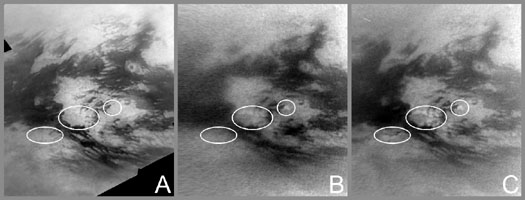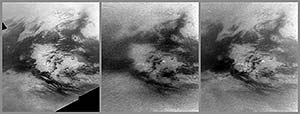|
COMETS EARTH JUPITER KUIPER BELT MARS MERCURY METEORITES NEPTUNE OORT CLOUD PLUTO SATURN SOLAR SYSTEM SPACE SUN URANUS VENUS ORDER PRINTS
PHOTO CATEGORIES SCIENCEVIEWS AMERICAN INDIAN AMPHIBIANS BIRDS BUGS FINE ART FOSSILS THE ISLANDS HISTORICAL PHOTOS MAMMALS OTHER PARKS PLANTS RELIGIOUS REPTILES SCIENCEVIEWS PRINTS
|
Related Documents
Download Options
 Annotation Image Click on the image for larger version Images from NASA's Cassini spacecraft show changes caused by methane rain in the bright Adiri region near the equator of Saturn's largest moon, Titan. Although no clouds are present in these images, the changes wrought by recent methane rainstorms are visible. These images show areas of brightened terrain within the already bright region known as Adiri. Adiri's terrain appears near the center of these frames. The dark, low-lying dune field known as Belet extends west from the left of these frames. Terrain south of Belet was soaked by methane rains in late 2010 (see PIA12817 and PIA12818). (Adiri and Belet have different brightnesses because they have different compositions.) The first image, panel A on the left, was taken on May 13, 2007, and shows what this area looked like earlier in the Cassini mission. Panels B and C were both captured on Jan. 15, 2011, 15 hours apart. New bright areas (within the white outlines of panels B and C) are thought to be on or near the surface of the moon. These bright objects are not high altitude clouds because they do not drift during the 15 hours between when panel B and panel C were taken. Scientists are still analyzing the findings, but these brightened spots could be low-lying fog or clouds in areas with higher amounts of moisture on the surface. They could also possibly be terrain that has been washed clean by methane rains. (The bright spots did not become brighter in the 15 hours between panels B and C. They appear brighter only because of a change in viewing geometry.) Titan's weather has been changing with the seasons, and storms now are more common at low latitudes such as those observed here. See PIA11667 to learn how the sun's illumination of the Saturnian system changed during the transition to spring in the northern hemispheres and to fall in the southern hemispheres of the planet and its moons. See PIA12813 to learn more about Titan's changing weather. These images were re-projected, and the view in each is centered on terrain at 7 degrees south latitude, 215 degrees west longitude. These images were taken with the Cassini spacecraft narrow-angle camera using a spectral filter sensitive to wavelengths of near-infrared light centered at 938 nanometers. The views were obtained at a range of distances from approximately 150,000 kilometers (93,000 miles) to 997,000 kilometers (620,000 miles) from Titan. Scale is about 7 kilometers (4 miles) per pixel in these re-projected images. |
